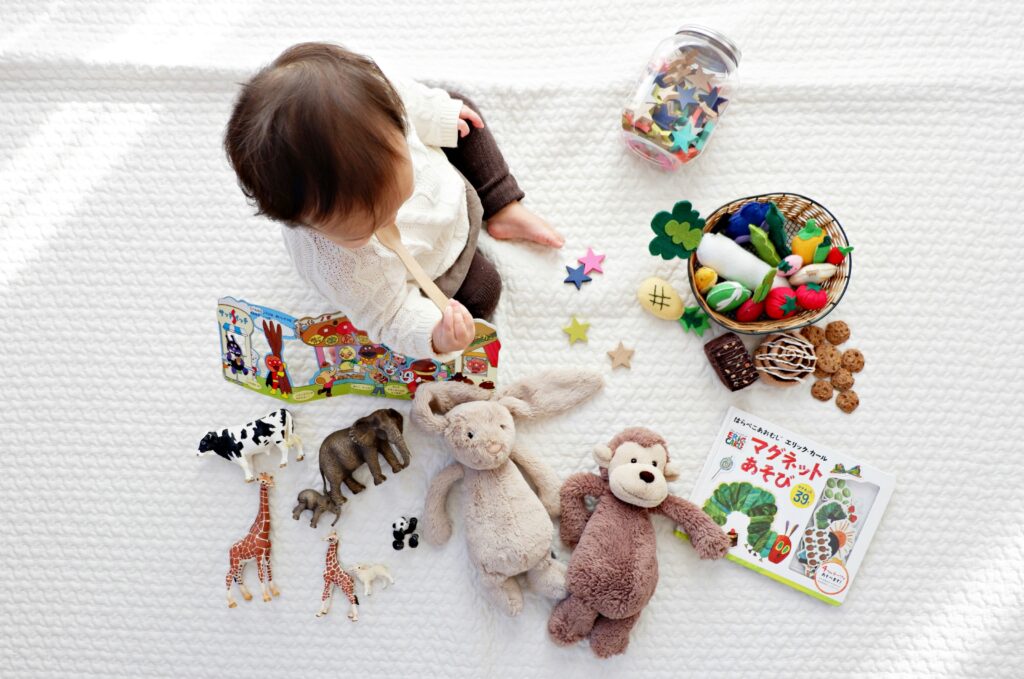By Anh Tran
February 13, 2024
Using toys, new study reveals cultural differences in children’s gender stereotyping development
Culture does have an impact on gender stereotyping, as seen by observed differences between Western and Eastern cultures.

Young infant playing. Photo licensed through Unsplash.
Children grow up in a world full of gender stereotypes. Like sponges, they absorb messages about what boys and girls are supposed to do or be. Using this knowledge, they develop their own understanding of gender and its connection to people, objects, and ideas. In turn, they learn to engage with others and the world based on this understanding.
Existing research shows us that children stereotype things more, based on gender, as they get older. This may be because of age-related changes in how children think and learn. However, this topic has mainly been studied in Western cultures. As a result, we do not fully know how the development of gender stereotyping plays out in other cultures.
Why care about this? Culture does have an impact on gender stereotyping, as seen by observed differences between Western and Eastern cultures. For instance, a 2020 study by Gutierrez and colleagues found that four-year-old boys in both Hong Kong and the United States followed gender stereotypes with the clothes they wore. However, the four-year-old boys in Hong Kong were less strict about sticking to boy clothes than their counterparts in the United States.
In a recent 2023 study, Miao Qian and colleagues from Canada, China, and Thailand came together to further fill this knowledge gap. They did so by investigating the development of gender stereotyping in four- to nine-year-olds from three different cultures: Canadian, Chinese, and Thai.
Both Canadian and Chinese cultures have traditionally recognized two genders: men and women. In contrast, Thailand has long acknowledged more than two genders in categories called pheet thii saam, which translates as “third sex/gender” from Thai to English. By including Thai children, this study also looks at how gender stereotyping development may be different in a culture with more than two genders.
Gender stereotyping was measured using toys in the Implicit Gender Association Test (IGAT). Here, in the first task, the child is asked to match pictures of typically traditional girl toys with girl faces and pictures of typically traditional boy toys with boy faces. In the second task, the child is asked to match pictures of typically traditional girl toys with boy faces and pictures of typically traditional boy toys with girl faces. The faster the child is in the first task, compared to the second task, the stronger their gender-toy stereotypes are.
Toys were specifically chosen because they are similarly stereotyped by children across both Western and Eastern cultures. As explained by Doug VanderLaan, an Associate Professor of Psychology at the University of Toronto Mississauga and senior author of this study, “One of the challenges of doing this kind of cross-cultural work is using stimuli or content for your testing instruments that you have a high degree of confidence will be relatively similarly perceived across cultures”.
Qian and her colleagues found that culture played a significant role in children’s development of gender-toy stereotyping. As predicted, Canadian children’s gender-toy stereotyping increased as they got older. Chinese children also showed gender-toy stereotyping, but it was weaker than the Canadian children’s results and did not change with age.
Surprisingly, Thai children engaged in strong gender-toy stereotyping across all ages. This is interesting because you may have thought that children from a culture with more than two genders would not really care about stereotypes that only consider two genders.
One possible explanation for this is that Thai gender stereotypes are more descriptive rather than prescriptive. “A descriptive stereotype describes a stereotype where people understand that one group tends to do something or have some characteristic more than members of another group,” explains VanderLaan, “Whereas prescriptive stereotypes mean more like this is an idea about the way that males are and the way that females are, but it’s something you have to do”. In other words, Thai children’s gender stereotypes describe what girls and boys commonly do and are, rather than rules that dictate what girls and boys do and are. Thus, Thai culture can have strong gender stereotypes, while also being accepting of people who challenge these stereotypes. When someone has strong descriptive gender stereotypes, they believe that girls and boys are most often a certain way, but that exceptions to these beliefs exist. In Thai culture, people who are the exception are considered to be pheet thii saam, which are socially accepted third gender/sex categories.
Another possible explanation for this finding is that the Thai language draws people’s attention to gender more than English, Mandarin, and Cantonese. For instance, every sentence and phrase in Thai ends with a term marking politeness, which differs depending on whether you are masculine or feminine. As a result, “Thai language itself reminds people very regularly about the distinction between males and females…”, says VanderLaan. And when the differences between genders are constantly highlighted, Thai children “…get the message that gender is important…” and thus, “…endorse stereotypes…”, states VanderLaan.
Such a study shows us how important research across cultures is. It enhances psychology’s understanding of how gender stereotyping develops, not just in children from the West, but also in children from other places around the world. As VanderLaan says, “…we can’t assume that people from Western cultures are representative of humanity as a whole…we actually have to go to other populations and investigate questions about psychology with other populations to get a more complete picture and to actually achieve our goals as a scientific discipline”.
Qian, M., Wong, W. I., Nabbijohn, A. N., Wang, Y., MacMullin, L. N., James, H. J., Fu, G., Zuo, B., & VanderLaan, D. P. (2023). Children’s implicit gender-toy association development varies across cultures. Developmental Psychology. In press.
